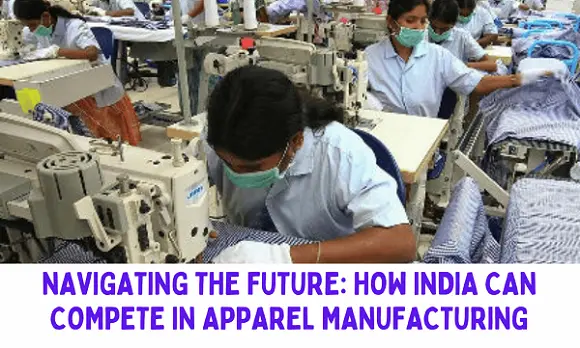Navigating the Future: How India Can Compete in the Apparel Manufacturing Industry with the Other Top Manufacturers in the World.
Introduction
In recent years, the apparel manufacturing industry has witnessed a significant shift in competition, with countries like Bangladesh, Sri Lanka, and Vietnam emerging as formidable players. To maintain its position as a leading apparel manufacturing destination, India must proactively address the challenges posed by these competitors. This article explores strategic approaches, focusing on cost-cutting measures, investments in automation and compliance, and optimizing technical parameters. So here we go Navigating the Future: How India Can Compete in the Apparel Manufacturing Sector in detail below.
What are the key things for India to Compete in the Apparel Manufacturing
- Cost-Cutting Measures
- Investing in Automation
- Compliance and Quality Standards
- Optimizing Technical Parameters
- Reducing Lead Times

Cost-Cutting Measures
1. Streamlined Supply Chain:
India can enhance its competitiveness by optimizing its supply chain management. This involves fostering strong relationships with suppliers, negotiating favorable terms, and implementing efficient inventory management systems to minimize costs and increase operational efficiency. A strong material sourcing process helps a lot.
2. Energy Efficiency:
Embracing energy-efficient manufacturing processes can significantly reduce operational costs. Implementing energy-saving technologies, such as LED lighting, energy-efficient machinery, and renewable energy sources, can help lower energy consumption and expenses.
3. Skilled Workforce:
Developing a skilled and productive workforce is essential for cost reduction. Investing in training programs and skill enhancement initiatives ensures that employees perform their tasks efficiently, reducing waste and rework while improving overall productivity.
Investing in Automation
1. Robotics and Machinery:
Automation technologies, such as robotics and advanced machinery, can significantly improve productivity, precision, and speed in the apparel manufacturing process. Integrating automated systems for tasks like cutting, sewing, and quality control can help reduce labor costs, increase output, and improve overall product quality. Bangladesh is well ahead in the less labor cost.
2. Data Analytics:
Leveraging data analytics and artificial intelligence can provide valuable insights for process optimization and resource allocation. By analyzing production data, manufacturers can identify bottlenecks, predict demand patterns, and make data-driven decisions to enhance efficiency and reduce costs.
Compliance and Quality Standards
1. Ethical Sourcing and Sustainability:
Adhering to international labor and sustainability standards is crucial for maintaining a competitive edge. Implementing fair labor practices, ensuring worker safety, and adopting sustainable manufacturing processes can enhance the brand image and attract environmentally conscious consumers.
2. Certifications and Audits:
Obtaining certifications, such as ISO standards or social compliance certifications, demonstrates a commitment to quality and responsible business practices. Regular internal and third-party audits can ensure compliance with these standards, boosting customer trust and confidence.
Optimizing Technical Parameters
1. Product Innovation:
Constantly innovating and staying ahead of market trends can help Indian manufacturers differentiate their products. Investing in research and development to create unique designs, incorporating advanced materials, and adopting new manufacturing techniques can give India a competitive edge.
2. Quality Control:
Implementing stringent quality control measures throughout the manufacturing process ensures that products meet international standards. Emphasizing quality at every stage, from raw material procurement to final product inspection, can help build a reputation for excellence and reliability.
Reducing Lead Times
1. Standardization and Simplification:
Standardizing processes and simplifying operations can streamline production and reduce lead times. By establishing clear standard operating procedures (SOPs) and training employees on efficient work methods, companies can eliminate unnecessary variations and increase productivity. And follow all the best practices of apparel manufacturing.
2. Effective Communication and Information Sharing:
Clear and timely communication across all stakeholders is essential for reducing lead times. Efficient communication channels, such as real-time production tracking systems and collaborative platforms, facilitate better coordination and enable faster decision-making. Timely sharing of information, such as order details, specifications, and changes, ensures smooth production flow and reduces lead times.
3. Lean Manufacturing Practices:
Implementing lean manufacturing principles can help eliminate waste and improve efficiency. This includes identifying and eliminating non-value-added activities, optimizing production flows, and minimizing bottlenecks. By improving process efficiency, lead times can be significantly reduced. To Compete in Apparel Manufacturing with the top suppliers in the world, a lean manufacturing process is one of the key things for India.
Conclusion:
As India faces increasing competition in the global apparel manufacturing industry, it is essential to adopt a proactive approach. By implementing cost-cutting measures, investing in automation and compliance, and optimizing technical parameters, India can enhance its competitiveness and continue to thrive in this evolving landscape. With a focus on innovation, quality, and sustainable practices, India has the potential to maintain its position as a preferred destination for apparel manufacturing. That’s all, How India Can Compete in the Apparel Manufacturing Industry with the Other Top Manufacturers in the World. Any other views? Please put it in the comment box.
About the Author –
Jagrit Sharma, Industrial Engineering Head at Vardhman Apparels, brings expertise in optimizing manufacturing processes and driving efficiency, With a focus on delivering results.
